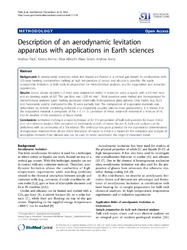Description of an aerodynamic levitation apparatus with applications in Earth sciences
Zeitschrift: Geochemical Transactions, 201011, 4: - 16
DOI: https://doi.org/10.1186/1467-4866-11-4
Persistent URL: http://resolver.sub.uni-goettingen.de/purl?gldocs-11858/7093
Persistent URL: http://resolver.sub.uni-goettingen.de/purl?gldocs-11858/7093
Pack, Andreas; Kremer, Katrina; Albrecht, Nina; Simon, Klaus; Kronz, Andreas, 2010: Description of an aerodynamic levitation apparatus with applications in Earth sciences. In: Geochemical Transactions, Band 11, 4, DOI: 10.1186/1467-4866-11-4.
 |
Dokument öffnen: |
Background: In aerodynamic levitation, solids and liquids are floated in a vertical gas stream. In combination with
CO2-laser heating, containerless melting at high temperature of oxides and silicates is possible. We apply
aerodynamic levitation to bulk rocks in preparation for microchemical analyses, and for evaporation and reduction
experiments.
Results: Liquid silicate droplets (~2 mm) were maintained stable in levitation using a nozzle with a 0.8 mm bore
and an opening angle of 60°. The gas flow was ~250 ml min-1. Rock powders were melted and homogenized for
microchemcial analyses. Laser melting produced chemically homogeneous glass spheres. Only highly (e.g. H2O)
and moderately volatile components (Na, K) were partially lost. The composition of evaporated materials was
determined by directly combining levitation and inductively coupled plasma mass spectrometry. It is shown that
the evaporated material is composed of Na > K >> Si. Levitation of metal oxide-rich material in a mixture of H2
and Ar resulted in the exsolution of liquid metal.
Conclusions: Levitation melting is a rapid technique or for the preparation of bulk rock powders for major, minor
and trace element analysis. With exception of moderately volatile elements Na and K, bulk rock analyses can be
performed with an uncertainty of ± 5% relative. The technique has great potential for the quantitative determination
of evaporated materials from silicate melts. Reduction of oxides to metal is a means for the extraction and analysis of
siderophile elements from silicates and can be used to better understand the origin of chondritic metal.
Statistik:
ZugriffsstatistikSammlung:
- Geologie [933]

